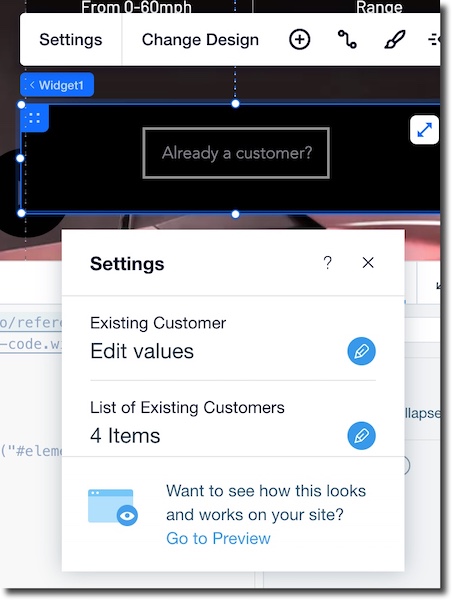Use the Widget API When Editing a Site
After a Widget API was defined in Blocks and the widget is now installed on a site, you can easily access the Widget API from the Wix Editor or Wix Studio.
Important Any changes that you make to the API while editing a site, only impact this specific site. The original widget is not impacted. If this isn't your intention and you want to edit the Widget API so that it updates on all sites using the widget, edit it in Wix Blocks.
Access Widget API Properties
Access properties through the Settings panel
Any widget that has properties, gets a default Settings panel. A widget with no properties will not have this panel.
- Select the widget in Wix Studio or Wix Editor.
- Click Settings in the widget's action bar to access its properties.
- Edit the properties in the Settings panel. Note: Your changes will only apply to the site you're editing.
- Click Preview to see how your widget works on this site.

Access properties through a custom panel
You can also let users set the properties through a custom panel that you created. Note that if you connect the custom panel to the widget's the Settings button, the default Settings panel will not be available.
Access Properties through code
-
Select the widget in Wix Studio or Wix Editor.
-
をクリックする。 Properties and Events
 icon to view the widget's ID.
icon to view the widget's ID. 
-
Use the syntax:
$w("#<widgetId>").<propertyName>to access properties (use extra dots if the property is an object and you want to access its inner properties). For example, let's log the name of our customer from the shopping widget to the console.
1
Access widget API events
When your widget is installed on a site, site creators can see the event name in their Velo Properties and Events  panel, in the format of
panel, in the format of on<EventName>, for example, onAddedToCart. There are a few things they can do with this event name:
Create a function to handle the event
-
Select the widget in the site editor.
-
Click on the name of the event in the Properties and Events panel.
-
Write the code to handle it in the empty function that appears in your Velo IDE.

Get data from the event
If you want to handle data from this event, you must add it as an argument (it's not added automatically). For example:
1
Use the event in the onReady() function
You can handle the event directly from the onReady() function of your site. For example:
1
注
Note that the condition for firing the event was defined in Blocks, while the actions to take when handling the event are defined in the site that installed the widget.
Access widget API functions
Access your Widget API functions in your site's code easily, with Velo's auto-complete.
For example, when an item was successfully added to the cart - you can notify the user.
Once you begin to write the functions name (such as "add"), Velo auto completes so you can see what functions are available:

Then you can use the function in your code, for example:
1